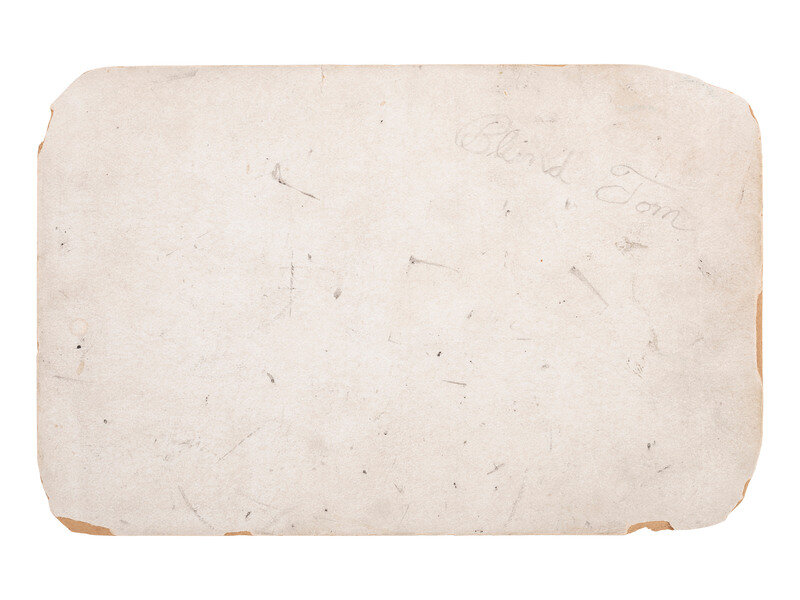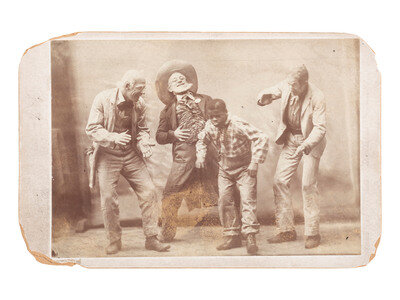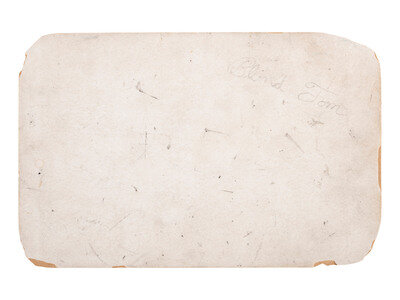Lot 488
[AFRICAN AMERICANA]. Cabinet card featuring a performance of a young man who resembles Thomas "Blind Tom" Wiggins (1849-1908), dancing with a trio of white men. N.p., n.d.
Sale 2057 - American Historical Ephemera and Photography
Oct 25, 2024
10:00AM ET
Live / Cincinnati
Own a similar item?
Estimate
$800 -
1,000
Lot Description
[AFRICAN AMERICANA]. Cabinet card featuring a performance of a young man who resembles Thomas "Blind Tom" Wiggins (1849-1908), dancing with a trio of white men. N.p., n.d.
5 1/2 x 3 7/8 in. cabinet photograph on unmarked cardstock mount. Pictured are three white men clapping and gesturing humorously as a young African American male subject seems to dance with his eyes closed. Pencil inscription to verso reads, "Blind Tom."
Though the latter subject bears a resemblance to "Blind Tom," the likely date of the photograph nearly prohibits the possibility of that identification. Cabinet cards were introduced in 1860, but did not become widely used until 1870. Thomas Wiggins was born in 1849, and the subject pictured here is a child. If this is an extremely early cabinet card, it is possible that it pictures Wiggins, though this would be a heretofore unknown image of him. If not, the image depicts a strange performance providing entertainment at the apparent expense of the young man wearing a plaid shirt and pinstriped pants.
Wiggins was born into slavery in Georgia, and was purchased as a young child with his parents by James Neil Bethune (1803-1895). Blind at birth, Tom’s musical talent was recognized early and Bethune leased Tom to a Barnum-style spectacle producer at the tender age of 8. He performed as often as four times a day earning his enslaver over $100,000 a year. In 1860, he visited Congress and played for President James Buchanan, possibly the first featured performance by an African American at the White House. He almost certainly earned more than any other pianist of the day, though it is the tragic reality that his earnings went to neither him nor his family.
Despite the outcome of the Civil War, Tom by any practical measure never seems to have gained his own freedom. Declared non compos mentis, General Bethune applied for Tom’s guardianship and continued to exploit his labor. In 1875, Bethune transferred management of Tom to his son John. After John’s death, Tom was at the center of a fierce custody battle. In the proceedings, he is often written about as though he was property, rather than a person. Even in 1895, when Bethune was on his deathbed, the New York Times headline read, “The Owner of ‘Blind Tom’ Ill.”
Musically, he is best remembered for composing The Battle of Manassas (1861 or 1862) which poignantly represents the complicated life of Blind Tom. The piece memorializes the First Battle of Bull Run (known by Confederates as the First Battle of Manassas), the first major battle of the Civil War and a decisive victory for the South. It was met with critical acclaim by white audiences and newspapers, and possibly used to raise money for the Confederate cause. Black voices are silent, with African American newspapers having distanced themselves from Tom, believing that white slaveowners used Tom to perpetuate stereotypes and line their own pockets. The piece itself, described as a tone poem, demonstrates Tom’s remarkable capability of capturing the atmosphere of a scene, recreating the sounds of the battlefield. Notably, it is one of the first examples of tone clusters, used to represent cannon fire. The piece was played continuously at nearly every concert until his death in 1908.
Though the latter subject bears a resemblance to "Blind Tom," the likely date of the photograph nearly prohibits the possibility of that identification. Cabinet cards were introduced in 1860, but did not become widely used until 1870. Thomas Wiggins was born in 1849, and the subject pictured here is a child. If this is an extremely early cabinet card, it is possible that it pictures Wiggins, though this would be a heretofore unknown image of him. If not, the image depicts a strange performance providing entertainment at the apparent expense of the young man wearing a plaid shirt and pinstriped pants.
Wiggins was born into slavery in Georgia, and was purchased as a young child with his parents by James Neil Bethune (1803-1895). Blind at birth, Tom’s musical talent was recognized early and Bethune leased Tom to a Barnum-style spectacle producer at the tender age of 8. He performed as often as four times a day earning his enslaver over $100,000 a year. In 1860, he visited Congress and played for President James Buchanan, possibly the first featured performance by an African American at the White House. He almost certainly earned more than any other pianist of the day, though it is the tragic reality that his earnings went to neither him nor his family.
Despite the outcome of the Civil War, Tom by any practical measure never seems to have gained his own freedom. Declared non compos mentis, General Bethune applied for Tom’s guardianship and continued to exploit his labor. In 1875, Bethune transferred management of Tom to his son John. After John’s death, Tom was at the center of a fierce custody battle. In the proceedings, he is often written about as though he was property, rather than a person. Even in 1895, when Bethune was on his deathbed, the New York Times headline read, “The Owner of ‘Blind Tom’ Ill.”
Musically, he is best remembered for composing The Battle of Manassas (1861 or 1862) which poignantly represents the complicated life of Blind Tom. The piece memorializes the First Battle of Bull Run (known by Confederates as the First Battle of Manassas), the first major battle of the Civil War and a decisive victory for the South. It was met with critical acclaim by white audiences and newspapers, and possibly used to raise money for the Confederate cause. Black voices are silent, with African American newspapers having distanced themselves from Tom, believing that white slaveowners used Tom to perpetuate stereotypes and line their own pockets. The piece itself, described as a tone poem, demonstrates Tom’s remarkable capability of capturing the atmosphere of a scene, recreating the sounds of the battlefield. Notably, it is one of the first examples of tone clusters, used to represent cannon fire. The piece was played continuously at nearly every concert until his death in 1908.
This lot is located in Cincinnati.
Condition Report
Contact Information
Auction Specialist



